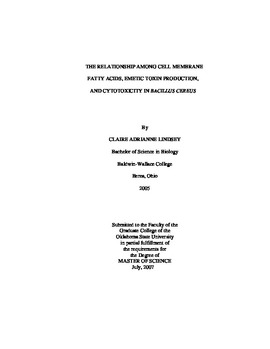| dc.contributor.advisor | Glass, R. Thomas | |
| dc.contributor.author | Lindsey, Claire Adrianne | |
| dc.date.accessioned | 2014-04-15T18:38:11Z | |
| dc.date.available | 2014-04-15T18:38:11Z | |
| dc.date.issued | 2007-07-01 | |
| dc.identifier.uri | https://hdl.handle.net/11244/8550 | |
| dc.description.abstract | The purpose of this study was to determine if there is a correlation among cell membrane fatty acids, emetic toxin production, and cytotoxicity in Bacillus cereus. B. cereus was used as a surrogate for Bacillus anthracis, the causative agent for anthrax. Four B. cereus strains were selected (F4810/72, NC7401, Arnold and ATCC 14579) because the strains phenotypic differences with regards to emetic toxin production. Analyses of B. cereus growth were performed using optical density readings. Samples were harvested at early and late stationary growth phase and centrifuged. The culture filtrate was partially purified for the emetic toxin cereulide. The cell pellet was washed with deionized H20 and kept for gas chromatography/mass spectral scans (GCMS). In vitro MTT and mitochondria permeability assays were employed to determine emetic toxin concentration and cytotoxicity. GCMS scans were performed on the cell pellet using a programmed method to determine differences in fatty acid composition. Statistical analyses of the slopes of B. cereus strains in exponential phase showed no differences between the four strains. The in vitro MTT assay results revealed differences in heat-stable toxin(s) concentrations distinguishing emetic from non-emetic B. cereus strains. Heat-stable toxin(s) concentration increased from early to late stationary phase for each B. cereus strain. Elevated concentrations of heat-stable toxin(s) for emetic strains when compared to non-emetic strains were determined to be due to cereulide production. GCMS scans of fatty acid composition of the four B. cereus strains showed differences, specifically distinguishing the fatty acid content of B. cereus stain F4810/72 from non-emetic strains. The emetic strains were differentiated from non-emetic strains at iC15:0 fatty acid in early and late stationary phase growth. The fatty acid content of emetic strains changed significantly from early to late stationary phase more than non-emetic strains of B. cereus. Odd numbered iso/anteiso ratios significantly distinguished F4810/72 from all other strains employed. Overall, a correlation among cell membrane fatty acids, emetic toxin production, and cytotoxicity of B. cereus is probable but cannot be definitively defined from the results of this study. | |
| dc.format | application/pdf | |
| dc.language | en_US | |
| dc.publisher | Oklahoma State University | |
| dc.rights | Copyright is held by the author who has granted the Oklahoma State University Library the non-exclusive right to share this material in its institutional repository. Contact Digital Library Services at lib-dls@okstate.edu or 405-744-9161 for the permission policy on the use, reproduction or distribution of this material. | |
| dc.title | Relationship Among Cell Membrane Fatty Acids, Emetic Toxin Production, and Cytotoxicity in Bacillus Cereus | |
| dc.type | text | |
| dc.contributor.committeeMember | Allen, Robert W. | |
| dc.contributor.committeeMember | Conrad, Robert S. | |
| dc.contributor.committeeMember | Champlin, Franklin R. | |
| osu.filename | Lindsey_okstate_0664M_2403.pdf | |
| osu.college | Agricultural Sciences and Natural Resources | |
| osu.accesstype | Open Access | |
| dc.description.department | Department of Biochemistry and Molecular Biology | |
| dc.type.genre | Thesis | |
| dc.subject.keywords | bacillus cereus | |
| dc.subject.keywords | cereulide | |
| dc.subject.keywords | fatty acids | |
| dc.subject.keywords | cytotoxicity | |
| dc.subject.keywords | bacillus anthracis | |
